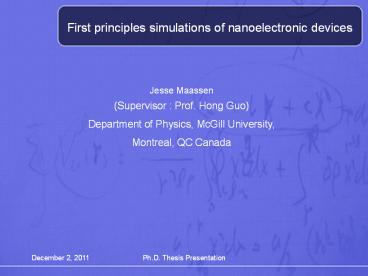First principles simulations of nanoelectronic devices - PowerPoint PPT Presentation
1 / 24
Title:
First principles simulations of nanoelectronic devices
Description:
First principles simulations of nanoelectronic devices Jesse Maassen (Supervisor : Prof. Hong Guo) Department of Physics, McGill University, Montreal, QC Canada – PowerPoint PPT presentation
Number of Views:105
Avg rating:3.0/5.0
Title: First principles simulations of nanoelectronic devices
1
First principles simulations of nanoelectronic
devices
Jesse Maassen (Supervisor Prof. Hong
Guo) Department of Physics, McGill University,
Montreal, QC Canada
2
Why first principles theory?
3
Why first principles theory?
4
How to calculate transport properties?
Taylor et al., PRB 63, 245407 (2001) Waldron et
al., PRL 97, 226802 (2006) Maassen et al., IEEE
(submitted)
5
Applications.
- Graphene-metal interface
- Localized doping in Si nano-transistors
- Dephasing in nano-scale systems
Maassen et al., Appl. Phys. Lett. 97, 142105
(2010) Maassen et al., Nano. Lett. 11,151 (2011)
6
Applications.
- Graphene-metal interface
- Localized doping in Si nano-transistors
- Dephasing in nano-scale systems
Maassen and Guo, preprint to be submitted
7
Applications.
- Graphene-metal interface
- Localized doping in Si nano-transistors
- Dephasing in nano-scale systems
Maassen et al., PRB 80, 125423 (2009)
8
Applications.
- Graphene-metal interface
- Localized doping in Si nano-transistors
- Dephasing in nano-scale systems
Maassen et al., PRB 80, 125423 (2009)
9
Application Graphene-metal interface
- Motivation
- Graphene has interesting properties (i.e., 2D
material, zero gap, linear dispersion bands, ).
- For electronics, all graphene sheets must be
contacted via metal electrodes (source/drain).
- Theoretical studies exclude accurate treatment of
electrodes.
- How does the graphene/metal interface affect the
response of a device?
10
Application Graphene-metal interface
- Transport properties
11
Application Graphene-metal interface
- Atomic structure
- Cu, Ni and Co (111) have in-place lattice
constants that almost match that of graphene.
- Equilibrium interface structure determined from
atomic relaxations.
Maassen et al., Appl. Phys. Lett. 97, 142105
(2010) Maassen et al., Nano. Lett. 11,151 (2011)
12
Application Graphene-metal interface
- Ni(111) contact
- Linear dispersion bands near Fermi level.
- Zero band gap.
- States only in the vicinity of K.
13
Application Graphene-metal interface
- Ni(111) contact
- Strong hybridization with metal
- Band gap opening
- Graphene is spin-polarized
Maassen et al., Nano. Lett. 11, 151 (2011)
14
Application Graphene-metal interface
- Ni(111) contact
15
Application Graphene-metal interface
- Ni(111) contact
16
Application Localized doping in Si
nano-transistors
- Motivation
- Leakage current accounts for 60 of energy in
transistors.
- Two sources (i) gate tunneling and (ii)
source/drain tunneling.
- How can highly controlled doping profiles affect
leakage current ?
17
Application Localized doping in Si
nano-transistors
- Structure n-p-n and p-n-p.
- Channel doping B or P.
- L 6.5 nm ? 15.2 nm
- Si band gap 1.11 eV
Technical details regarding random doping,
large-scale modeling and predicting accurate
semiconductor band gaps can be found in the
thesis.
18
Application Localized doping in Si
nano-transistors
- GMAX / GMIN 50.
- Lowest G with doping in the middle of the channel.
Maassen and Guo, preprint to be submitted
19
Application Localized doping in Si
nano-transistors
Maassen and Guo, preprint to be submitted
20
Application Localized doping in Si
nano-transistors
Maassen and Guo, preprint to be submitted
21
Application Localized doping in Si
nano-transistors
- G decreases with L.
- Variations in G increase dramatically with L.
Maassen and Guo, preprint to be submitted
22
Application Localized doping in Si
nano-transistors
- G decreases with L.
- Variations in G increase dramatically with L.
Maassen and Guo, preprint to be submitted
23
Summary
- First principles transport theory is a valuable
tool for quantitative predictions of
nanoelectronics, where atomic/quantum effects are
important.
- I determined that the effect of metallic contacts
(Cu, Ni, Co) can significantly influence device
characteristics. I found that the atomic
structure of the graphene/metal interface is
crucial for a accurate treatment.
- My simulations on localized doping profiles
demonstrated how leakage current can be
substantially reduced in addition to alleviating
device variations.
24
Thank you!
Questions ?































